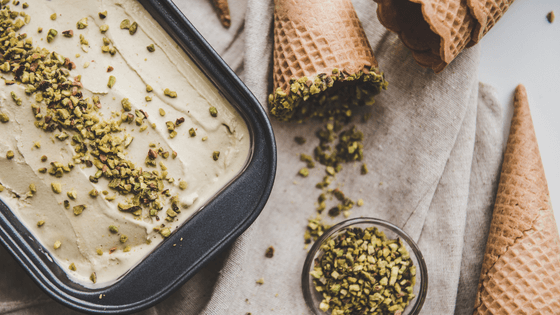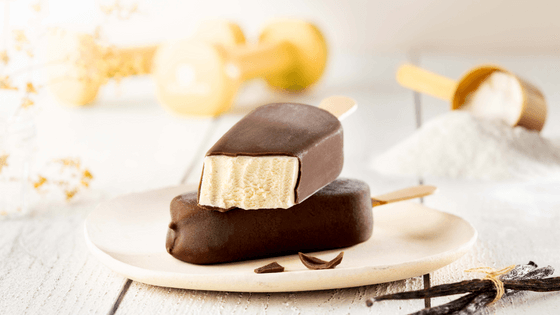
Choosing dairy proteins for the formulation of ice creams
For several years, now, the ice cream food market has been carving out a “good for health” niche. In order to meet the growing demands of health-conscious consumers, ice cream manufacturers have joined the ranks of the market innovators by offering products enriched with proteins and minerals. From an innovation point of view, the new ice creams identified on the market in recent years that claim a “high protein content” have an average protein level of around 8g/100g (for products released in 2021) [1]. The protein is derived exclusively from milk proteins and whey proteins.
Proteins with functional and nutritional benefits
Ice cream foods include various different product types. This article will focus in particular on those that contain dairy products, in other words: dairy ice creams that contain a minimum of 5 % milk fat, and ice creams that contain a minimum of 2.5 % milk fat or vegetable fat with a minimum of 6 % Milk Solid Non Fat (MSNF).
Proteins also play an important part in the sensory experience
Ice creams and dairy ice creams are complex preparations where the functionalization of fat is crucial. These products can be described as frozen foamed emulsions, and constitute one of the rare foods consumed frozen. Dairy proteins play a major role in the production of ice creams by stabilizing fat in the form of fat globules and then allowing the process of partial coalescence of these fat globules. The latter process is necessary to retain air during foaming. Proteins also play an important part in the sensory experience when tasting ice cream. In particular, they delay the melting of the ice cream when it is exposed to room temperature, reduce the feeling of coldness in the mouth and give the ice cream its coating texture.

As well as bringing the advantages of their functional properties, these proteins can also make an ice cream into a protein-enriched product. Today, high-protein ice creams have a smaller share of the market than traditional ice creams, but their development is of interest to many manufacturers. This is the case with the American market, which offers a lot of products of this type.
Selecting the most appropriate dairy proteins when formulating ice creams
How to improve ice cream properties and yields with dairy proteins
Which dairy proteins to choose when formulating ice cream depends on the intended product and the equipment used to make it. If working with turbines, for example, the initial formulation will directly condition the foaming characteristics of the ice cream. In a traditional ice cream, the proteins from the milk used in the recipe (skimmed or whole) are sufficient in quantity to ensure the formation and stabilization of the foamed emulsion. When the desired fat content is higher, a moderate addition (around 0.9 % to 1%) of high quality protein can improve the foaming. In this instance, the ideal proteins are native soluble proteins such as Pronativ® – Native Whey Protein. These proteins will have undergone only slight, if any, thermization and are therefore not denatured. Judicious use of native soluble protein (Pronativ® – Native Whey Protein) allows an extra gain of 10 % to 12% in volume. The ice cream contains more air, which can equate to significant economic gain. The use of Pronativ® – Native Whey Proteins stabilizes the air, thus offering greater smoothness and slightly delayed melting. This feature has already been advantageously exploited by artisanal ice cream makers using Pronativ®- Native Whey Protein. In a cost-reduction approach to formula, it is also possible to reduce the protein content in an ice cream by varying the nature of the proteins. Native whey proteins are very useful in this context too. An ice cream prepared with a protein content of 1 % provided by Pronativ®- Native Whey Protein will, for example, have melt stability properties equivalent to those of an ice-cream with a 3 % protein content from the milk used.
a moderate addition of high quality protein can improve the foaming
When working with a freezer, the foaming rate is established and regulated by the process, so the actual recipe will have less influence on the final result. The presence of these proteins is a real bonus for the product since they make it possible to improve the foaming while reducing the quantity of air.
Dairy proteins for the development of high protein ice creams
With high protein ice creams, the objective is no longer stabilization and foaming. It is to find a protein that can be used at a high concentration without creating technological difficulties during the manufacturing operations. However, not all dairy proteins are suitable when required in large quantities because problems can then arise with regard to heat stability and viscosity. Generally, 10 % to 15 % of protein needs to be added. These protein levels can cause higher viscosity during the preparation of recipes, which then results in coagulation during heat treatments.
In order to withstand heat treatment, heat stable proteins must be used. This is the big advantage of native micellar casein. Micellar casein exists in concentrate form (MCC) (60% protein/Dry matter) and isolate form (MCI) (88% protein/Dry matter) and allows the formulation of very creamy high-protein ice creams that have no metallic aftertaste or bitterness. When used in high protein recipes, a micellar casein such as Pronativ® – Native Micellar Casein has the added advantage of naturally creating the ideal viscosity, thus avoiding the necessity for texturizers in the product. These protein ice creams can therefore be formulated “without additives” while offering very good storage without loss of volume. In contrast with milk powder, native micellar casein also allows the formulation of recipes with a low lactose content.

Another advantage of our Pronativ® proteins is the formulation of recipes that can withstand extrusion, which is useful for ice cream in pots, for example. The delayed melting, a feature much sought-after in particular for the “soft serve” category, is a feature of the excellent heat stability.
The full range of dairy ingredients at Lactalis Ingredients is manufactured in our FSSC 22000 certified factories. It is also worth mentioning that the Pronativ® protein range (Native Whey Protein and Native Micellar Casein) is Kosher and Halal certified and originates in France. Our Pronativ® – Native Whey Protein product is also available in America in the isolate form.
We have a team of technical experts who will be happy to assess your needs and assist you with your development ideas. Do not hesitate to contact us.
Sources :
[1] Mintel Gnpd, November 2022















